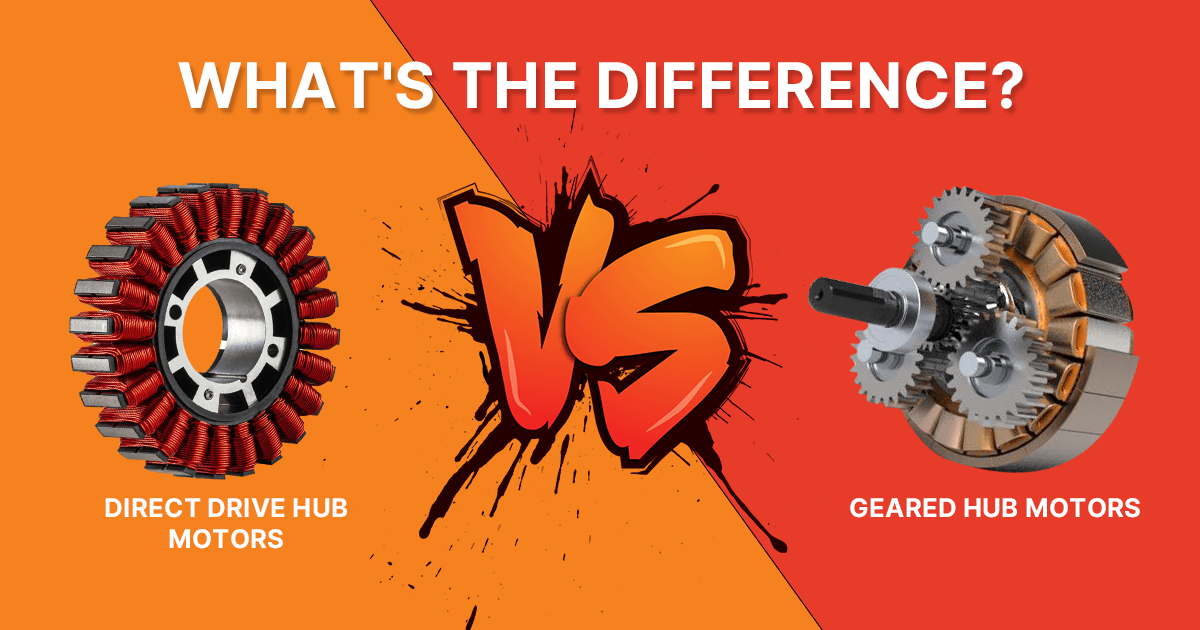If you are planning to buy an electric bike, you should learn about geared hub and direct drive motors, the two kinds of electric bike motors most commonly used in e-bikes. To help you make the right decision for your needs, here is a detailed comparison of gear hub and direct drive motors.
The origin of the hub motor can be traced back to 1900, when Porsche integrated power, transmission and braking devices into the motor of an electric car’s front wheel. With the development of electric cars, hub motors have been updated and used in the improvement of electric bikes.
Today, hub motor technology is well-tested and relatively inexpensive, occupying most of the market for electric bicycles.
According to the mechanical structure, electric bike motors are generally divided into two categories: "geared" and "gearless/direct drive".
Overview of geared hub motor
Like all electric motors, a geared hub motor uses magnetism produced by an electric current to turn a rotor that is connected to a shaft. Energy is transferred from the rotor to the shaft and then used to power a connected wheel. When starting the electric bicycle, a gear deceleration mechanism lowers the motor speed to meet the national standard requirements.
What is a gear hub motor?

The name "geared hub motor" comes from its composition: gears spinning inside the motor, without brushes or magnets. A geared hub motor is inconspicuous and looks almost indistinguishable from a normal bike, smaller and lighter, and even when mounted you can't tell the difference between it and a direct drive motor.
How does a gear hub motor work?
The inner part of a geared hub motor is actually a planetary gear system, consisting of a rotor/central gear and 3 planetary gears. Similar to the lever principle, the rotor/central gear continuously engages to transmit power through the planetary gears and then turns the outer casing, along with the wheels.
Overview of gearless/direct drive motor
In 1895, Ogden Bolton invented the direct-drive in-wheel electric bike, making him the first person to patent a battery-powered bicycle. This is a 10 volt/100-amp, single speed, electric bike with a DC hub motor.
What is gearless/direct drive motor?

Gearless hub motors (also known as direct-drive motors) have a traditional internal structure without a planetary gear reduction system. Its stator consists of the axle of the motor itself and the copper winding fixed on the axle. And the gearless hub motor generally has no clutch device inside, so it is necessary to overcome the electromagnetic resistance when the power is off.
How does a gearless/direct drive motor work?
The gearless hub motor directly relies on electromagnetic conversion to generate mechanical energy to drive the ebike. The advantage of the hub motor is that it can convert kinetic energy when pedaling or driving. But for the battery energy storage, the electromagnetic conversion efficiency is low.
Comparison of gear hub and direct drive motor
-
Weight & Volume
TAs the complexity of the structure of the stator increases, so do the volume and the weight of the gearless hub motor.
On the contrary, the geared hub motor is much lighter and you can enjoy the cycling with ease.
-
Top speed
To control the speed under the national standard, the rotor speed of the geared hub motor is reduced by its gear reduction system. So, the gearless hub motor has a higher top speed compared with gear hub motor.
-
Resistance
When the electric bike is operating, the resistance to the geared hub motor is less than that to the gearless motor.
The clutch device inside the geared motor breaks down the pedaling force directly to the rear wheel and does not affect the rotation of the electromagnetic structure inside the motor, so it does not cause too much extra resistance.
-
Terrain
The geared hub motor produces much higher torque, so they are not only good for daily commuting, but can also be a better option for hill climbing. With a gearless motor, you have to work very hard to achieve the same effect.
-
Battery lifespan
Geared hub motors can produce more energy with less power and the battery consumption is lower than direct drive motor. So, the battery of the ebike with a geared hub motor has a longer life.
-
Noise
Due to the operation of the gear reduction system, the gears in the hub produce slight noise. The direct drive motor has less mechanical friction, so the noise it produces is quieter.
-
Durability
As we mentioned above, the operation of the gear reduction system is conducted by continuously engaging the rotor/central gear. In the long run, the parts will be worn out, while gearless hub motor is not so easy to damage. But don’t be worried, the durability of a high-quality geared hub motor is also guaranteed.
-
Terrain
The geared hub motor produces much higher torque, so they are not only good for daily commuting, but can also be a better option for hill climbing. With a gearless motor, you have to work very hard to achieve the same effect.
Buyer's guide to e-bikes: direct drive vs. geared drive motor
The choice of which motor to get depends entirely on your needs. You should take all of the factors of your travel into account, such as weight, portability, top speed, torque, distance or resistance.
Compared with the direct drive motor, geared motors excel in terms of portability, torque, resistance, battery lifespan and efficiency.
So, if you do not have the ultimate pursuit of top speed and usually attach importance to the maintenance of your electric bike, a geared hub motor ebike is the best choice for you. Clik here to explore more high quality ebikes and make your life much easier.









Leave a comment
This site is protected by hCaptcha and the hCaptcha Privacy Policy and Terms of Service apply.